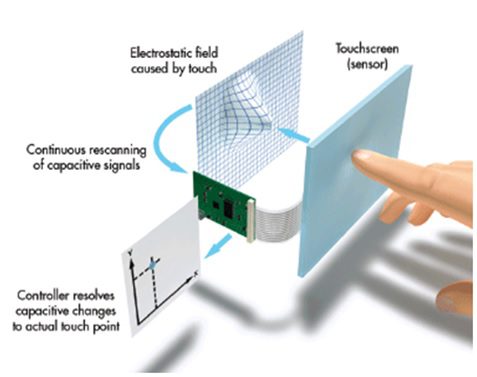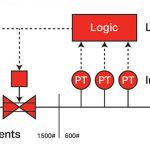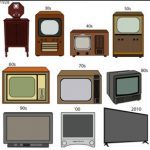Table of Contents
Touch Screen Display
Traditional input devices for computer systems include keyboards and mice. In recent years, touch screen technology has become widely used as a way to interact with computer systems, particular for mobile devices.
A touch screen is an electronic visual display that a user can control by touching the screen with one or more fingers. These screen allows for a much more direct interaction with what is displayed compared to a device like a mouse. These screens have become very common on tablet computers, smart phones and other mobile devices. Increasingly, regular laptop and desktop computers use touch displays so users can use both touch as well as more traditional ways of input. Touch screen technology has been around for a number of years but advanced touch screen technology has come on in leaps and bounds recently.

Component and Working of Touch Screen
A basic touch display is having a touch sensor, a controller, and a software driver as three main components. The touch screen is needed to be combined with a display and a PC to make a touch screen system.





Touch sensor:
The sensor generally has an electrical current or signal going through it and touching the screen causes a change in the signal. This change is used to determine the location of the touch of the screen.
Controller:
A controller will be connected between the touch sensor and PC. It takes information from the sensor and translates it for the understanding of PC. The controller determines what type of connection is needed.
Software driver:
It allows computers and touch screens to work together. It tells OS how to interact with the touch event information that is sent from the controller.
Types of Touch Screen Technology
This is a 2-dimensional sensing device made of 2 sheets of material separated by spacers. There are four main technologies for these types of screen: Resistive, Capacitive, Surface Acoustical wave (SAW), and infrared (IR)
Resistive Touch Screen Display
The first major technology that became successful is resistive touch screen technology. This uses a panel that consists of several layers, including two thin, electrically charged layers separated by a thin space. By pressing on the panel, these two layers touch and the location of the connection is recorded as the input. Resistive screen are relatively cheap and very resistant to liquids. The major downsides are that you need to actually press down with a certain amount of pressure and they have relatively poor contrast. As a result, resistive touch screens did not become widely used for computer systems but instead were developed as part as other electronic systems. For example, the display screens used in restaurants to enter orders and control panels in factories are often made of resistive touch screens.
Capacitive Touch Screen Display
The second major technology used in touch screens is capacitive sensing. A capacitive touch screen uses a layer of insulating material, such as glass, coated with a transparent conductor. The human body is also an electrical conductor, so touching the screen with your finger results in a change in the electrostatic field of the screen. A number of different approaches can be used to record the location of the touch. One of the most common ways is to use a fine grid of capacitors, which record the change in the electrostatic field. These capacitors are organized by rows and columns, and they function independently of each other. This makes it possible to record multiple touches at the same time, known as multi-touch technology.
Application of Touch Screen technology
Touch screens have been used in many different devices over the years including ATM machines, cash registers in grocery stores, diagnostic tools in automobile repair shops, and of course in computers.
A real-time Application: Controlling home appliances using Touch Screen Technology
Read Also:-
Related Search:-





Two out of three (2oo3) Logic
Two out of three (2oo3) Logic





Control Valves Accessories
Control Valves Accessories





What is source and sink in plants?
What is source and sink in plants?





Display Devices
Display Devices





Electrical Transducer
Electrical Transducer




